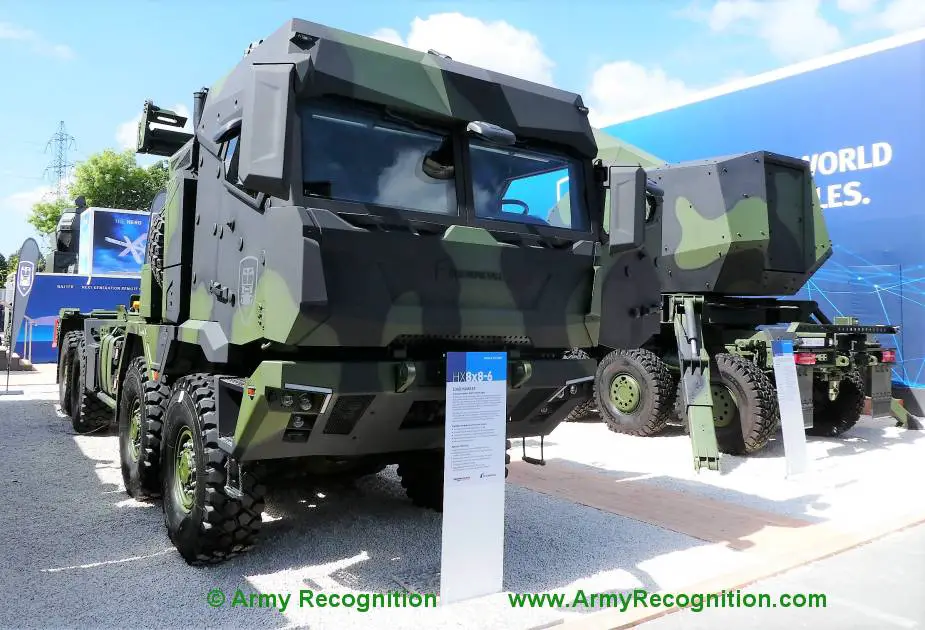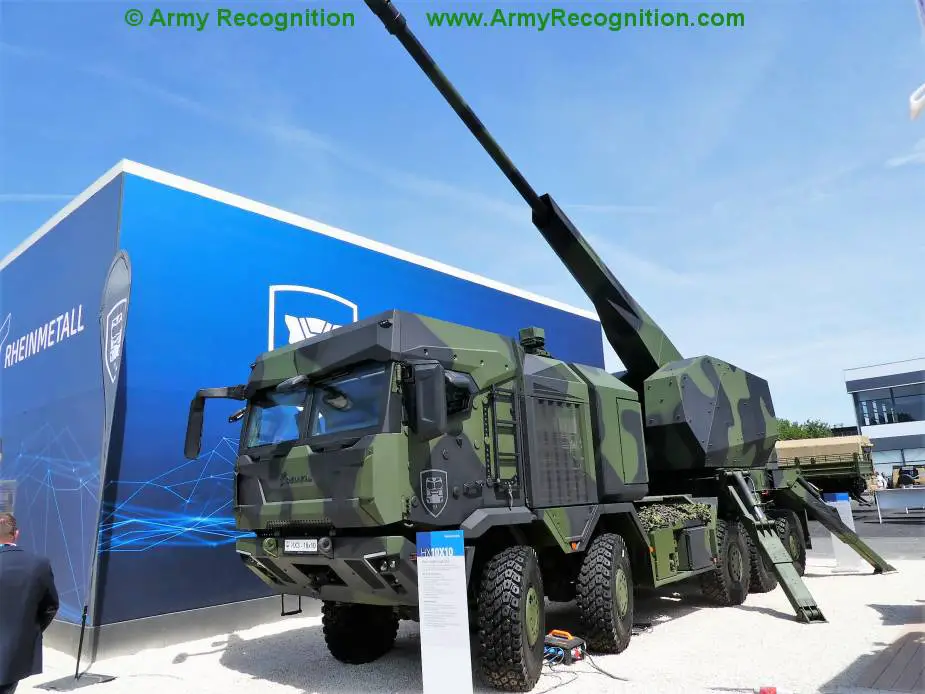Breaking news
RMMV Rheinmetall MAN showcases HX3 range of all-wheel-drive trucks.
Rheinmetall HX3 – the new generation of vehicles equally suited for logistical and tactical scenarios Made by Rheinmetall MAN Military Vehicles, the HX family is among the most widely used range of military trucks anywhere. Over 15,000 vehicles are now in service worldwide. A military-off-the-shelf family of vehicles, HX trucks are systematically designed for maximum durability, mobility, ease of use and modularity, effectively placing them in a class of their own.
Follow Army Recognition on Google News at this link

The HX3’s completely overhauled cab design delivers even greater ease of operation and crew protection, while various assistance systems assure enhanced safety during routine operations. (Picture source: Army Recognition)
In May 2021 Rheinmetall unveiled its latest generation of globally tried-and-tested HX trucks. New technologies make these future-proof vehicles more than a match for military and automotive megatrends. In effect, they have been completely redesigned. Among other things, users today expect improved protection, enhanced mobility, improved driving comfort and a digital interface that enables even greater operational flexibility and future performance upgrades. At the same time, however, the new generation preserves the highly prized core strengths of the HX2 and the family-driven concept.
The HX3’s completely overhauled cab design delivers even greater ease of operation and crew protection, while various assistance systems assure enhanced safety during routine operations. Completely reworked, the electronic and electrical architecture and assistance systems – including Emergency Brake Assist/EBA, Adaptive Cruise Control/ACC and Lane Departure Warning/LDW – ensure the vehicle’s future viability, especially when it comes to autonomous driving. Standardized interfaces will make it possible to integrate future technologies such as truck platooning and other automated applications. Along with a robust chassis and high-performance engine, the vehicles can be equipped with an optional new active rear axle suspension system, which significantly enhances the vehicle’s performance both on and off-road.
More than ever, the new HX3 generation embodies a platform concept equally suited to logistic and tactical scenarios. The HX3 will basically be available in 4x4, 6x6, 8x8 and 10x10 versions, and characterised by an even wider array of variants and greater system diversity. Moreover, its traditional role as a logistics vehicle can be further enhanced thanks to new systems such as the fully automatic Automated Load Handling System, or ALHS, which can load both containers as well as flat racks.

HX3 in 10x10 self-propelled howitzer variant. (Picture source: Army Recognition)
At Eurosatory 2022, Rheinmetall’s wheeled self-propelled howitzer is on display, mounted on a high mobility HX 10x10 chassis. The HX3 can also serve as the mobility platform for the Skynex air defence system.
Since its foundation in 1889, Rheinmetall has been a world-leading centre of expertise for heavy artillery. The company’s new wheeled self-propelled howitzer is highly advanced, being specifically designed to meet international specifications for future-proofed indirect fire systems. Key criteria governing the system’s design include combining the operational reach of Rheinmetall’s high-mobility, operationally proven, HX military trucks with state-of-the-art howitzer technology, while simultaneously substantially extending the range of cannon artillery to gain range superiority over any enemy capability.
The Rheinmetall wheeled self-propelled howitzer is mounted on a high-mobility HX 10x10 chassis made by Rheinmetall MAN Military Vehicles. It is equipped with a highly protected cab and a fully automatic, remote-controlled artillery turret, which, though unmanned, can be entered by the crew. This means that it takes only two soldiers to operate the system from the safety of the armoured cab.
The turret can rotate and fire through 360 degrees, drawing on a turret magazine containing projectiles and propelling charges for forty rounds. The armament is the tried and tested L52 weapon system and as future growth potential the L52A1 or the L60 weapon systems – both currently under development. All weapons come from Rheinmetall. The L52A1 is an optimised version of the 155mm L52 weapon and has an enlarged gun chamber. With this, ranges of up to 68 kilometres can be achieved. The L60 can fire low-cost standard projectiles (boattail; base bleed; V-LAP) more than 80 kilometres. Precision-guided munitions such as the Vulcano will allow engaging high-value targets at even greater ranges.
Compared to other wheeled platforms, which are already hitting their weight and payload limits, using the HX 10x10 offers the advantage of the unused growth potential of circa 5 tonnes of additional load capacity. Given an assumed service life of 30-40 years, this additional payload could be used to incorporate a multitude of additional mission systems as well as for carrying extra ammunition. Moreover, because the howitzer was designed from the start for remote control and semi or fully-automatic operation, it can function without a crew. In keeping with the “human in the loop” principle, however, the fire order is never an autonomous decision.
When it comes to procurement and utilization, the howitzer offers an excellent price-performance ratio compared to traditional tracked self-propelled howitzers as well as other wheeled tactical vehicle-based systems, while at the same time substantially enhancing a core capability intrinsic to all howitzers: achieving favourable outcomes through range superiority. Thanks to the high-mobility HX 10x10 truck chassis, the artillery system can flexibly redeploy over large distances without additional logistic support, and with no need for routine maintenance or repairs upon arrival. Furthermore, logistic uniformity owing to the extensive use of HX trucks in the Bundeswehr, the British Army and numerous other armed forces will result in lower lifecycle costs, while simultaneously facilitating multinational operations, thus strengthening national and alliance defence capabilities.



















